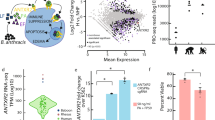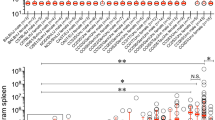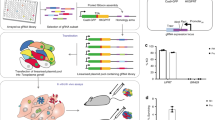Abstract
We examined whether survival of different rat strains administered anthrax lethal toxin is genetically determined. A reproducible test population of first filial generation hybrid rats was bred based on the susceptibility of progenitors to anthrax lethal toxin and to maximize genetic diversity across the strains. These rats were then tested with varying doses of anthrax lethal toxin. We found that all ‘sensitive’ strains died within 2 h following systemic administration of 240 μg/kg lethal toxin, while one strain survived following a five times higher dose (1.4 mg/kg). The ability of lethal toxin to lyse macrophage cultures derived from the bone marrow of these strains corresponded with in vivo results. We conclude that a rat test population can detect strain differences in response to anthrax lethal toxin. Survival is influenced by the host genome background and is likely due to a single gene with a recessive mode of inheritance.
This is a preview of subscription content, access via your institution
Access options
Subscribe to this journal
Receive 6 print issues and online access
$259.00 per year
only $43.17 per issue
Buy this article
- Purchase on Springer Link
- Instant access to full article PDF
Prices may be subject to local taxes which are calculated during checkout



Similar content being viewed by others
Abbreviations
- LeTx:
-
lethal toxin
- LF:
-
lethal factor
- PA:
-
protective antigen
- F1:
-
first filial generation
- SSLP:
-
simple sequence length polymorphism
- F344:
-
Fischer 344 rat
- LEW:
-
Lewis rat
- WKY:
-
Wistar-Kyoto rat
- BN:
-
Brown Norway rat
- CD-IGS:
-
Caesarian-Derived-International Genetic Standard rat
- LD100:
-
lethal dose resulting in 100% death
- QTL:
-
quantitative trait loci
- RMM:
-
rat macrophage medium
- GM-CSF:
-
granulocyte–macrophage colony stimulating factor
References
Beall FA, Dalldorf FG . The pathogenesis of the lethal effect of anthrax toxin in the rat. J Infect Dis 1966; 116: 377–389.
Fish DC, Klein F, Lincoln RE, Walker JS, Dobbs JP . Pathophysiological changes in the rat associated with anthrax toxin. J Infect Dis 1968; 118: 114–124.
Welkos SL, Keener TJ, Gibbs PH . Differences in susceptibility of inbred mice to Bacillus anthracis. Infect Immun 1986; 51: 795–800.
Roberts JE, Watters JW, Ballard JD, Dietrich WF . Ltx1, a mouse locus that influences the susceptibility of macrophages to cytolysis caused by intoxication with Bacillus anthracis lethal factor, maps to chromosome 11. Mol Microbiol 1998; 29: 581–591.
Bradley KA, Mogridge J, Mourez M, Collier RJ, Young JA . Identification of the cellular receptor for anthrax toxin. Nature 2001; 414: 225–229.
Liu S, Leppla SH . Cell surface tumor endothelium marker 8 cytoplasmic tail-independent anthrax toxin binding, proteolytic processing, oligomer formation, and internalization. J Biol Chem 2003; 278: 5227–5234.
Wei W, Lu Q, Chaudry GJ, Leppla SH, Cohen SN . The LDL receptor-related protein LRP6 mediates internalization and lethality of anthrax toxin. Cell 2006; 124: 1141–1154.
Boyden ED, Dietrich WF . Nalp1b controls mouse macrophage susceptibility to anthrax lethal toxin. Nat Genet 2006; 38: 240–244.
Park JM, Greten FR, Li ZW, Karin M . Macrophage apoptosis by anthrax lethal factor through p38 MAP kinase inhibition. Science 2002; 297: 2048–2051.
Vitale G, Bernardi L, Napolitani G, Mock M, Montecucco C . Susceptibility of mitogen-activated protein kinase kinase family members to proteolysis by anthrax lethal factor. Biochem J 2000; 352 (Part 3): 739–745.
Scobie HM, Rainey GJ, Bradley KA, Young JA . Human capillary morphogenesis protein 2 functions as an anthrax toxin receptor. Proc Natl Acad Sci USA 2003; 100: 5170–5174.
Scobie HM, Wigelsworth DJ, Marlett JM, Thomas D, Rainey GJ, Lacy DB et al. Anthrax toxin receptor 2-dependent lethal toxin killing in vivo. PLoS Pathog 2006; 2: e111.
Duesbery NS, Webb CP, Leppla SH, Gordon VM, Klimpel KR, Copeland TD et al. Proteolytic inactivation of MAP-kinase-kinase by anthrax lethal factor. Science 1998; 280: 734–737.
Leppla S . The anthrax toxin complex. In: Alouf J (ed). Sourcebook of Bacterial Protein Toxins. Academic Press: New York, 1991, pp 277–302.
Friedlander AM . Macrophages are sensitive to anthrax lethal toxin through an acid-dependent process. J Biol Chem 1986; 261: 7123–7126.
Ezzell JW, Ivins BE, Leppla SH . Immunoelectrophoretic analysis, toxicity, and kinetics of in vitro production of the protective antigen and lethal factor components of Bacillus anthracis toxin. Infect Immun 1984; 45: 761–767.
McAllister RD, Singh Y, du Bois WD, Potter M, Boehm T, Meeker ND et al. Susceptibility to anthrax lethal toxin is controlled by three linked quantitative trait loci. Am J Pathol 2003; 163: 1735–1741.
Moayeri M, Martinez NW, Wiggins J, Young HA, Leppla SH . Mouse susceptibility to anthrax lethal toxin is influenced by genetic factors in addition to those controlling macrophage sensitivity. Infect Immun 2004; 72: 4439–4447.
Shibaya M, Kubomichi M, Watanabe T . The genetic basis of host resistance to Bacillus anthracis in inbred mice. Vet Microbiol 1991; 26: 309–312.
Steen RG, Kwitek-Black AE, Glenn C, Gullings-Handley J, Van Etten W, Atkinson OS et al. A high-density integrated genetic linkage and radiation hybrid map of the laboratory rat. Genome Res 1999; 9: AP1–AP8, insert..
Canzian F . Phylogenetics of the laboratory rat Rattus norvegicus. Genome Res 1997; 7: 262–267.
Thomas MA, Chen CF, Jensen-Seaman MI, Tonellato PJ, Twigger SN . Phylogenetics of rat inbred strains. Mamm Genome 2003; 14: 61–64.
Gibbs RA, Weinstock GM, Metzker ML, Muzny DM, Sodergren EJ, Scherer S et al. Genome sequence of the Brown Norway rat yields insights into mammalian evolution. Nature 2004; 428: 493–521.
Acknowledgements
The authors are grateful to Jordan Baye, Sally Korb and Yvette Harrington for excellent technical assistance. We thank Eric Boyden at Harvard University for assistance with the rat macrophage assay and Dr Simon Twigger at the Medical College of Wisconsin for development of the Strain Calculator. We thank Dr Ty Shockley for reviewing the manuscript. This work was funded through a grant provided by the National Institutes of Allergy and Infectious Diseases.
Author information
Authors and Affiliations
Corresponding author
Additional information
Duality of interest
RJ Roman and HJ Jacob are PhysioGenix founders and major stock holders.
Rights and permissions
About this article
Cite this article
Nye, S., Wittenburg, A., Evans, D. et al. Rat survival to anthrax lethal toxin is likely controlled by a single gene. Pharmacogenomics J 8, 16–22 (2008). https://doi.org/10.1038/sj.tpj.6500448
Received:
Revised:
Accepted:
Published:
Issue Date:
DOI: https://doi.org/10.1038/sj.tpj.6500448



